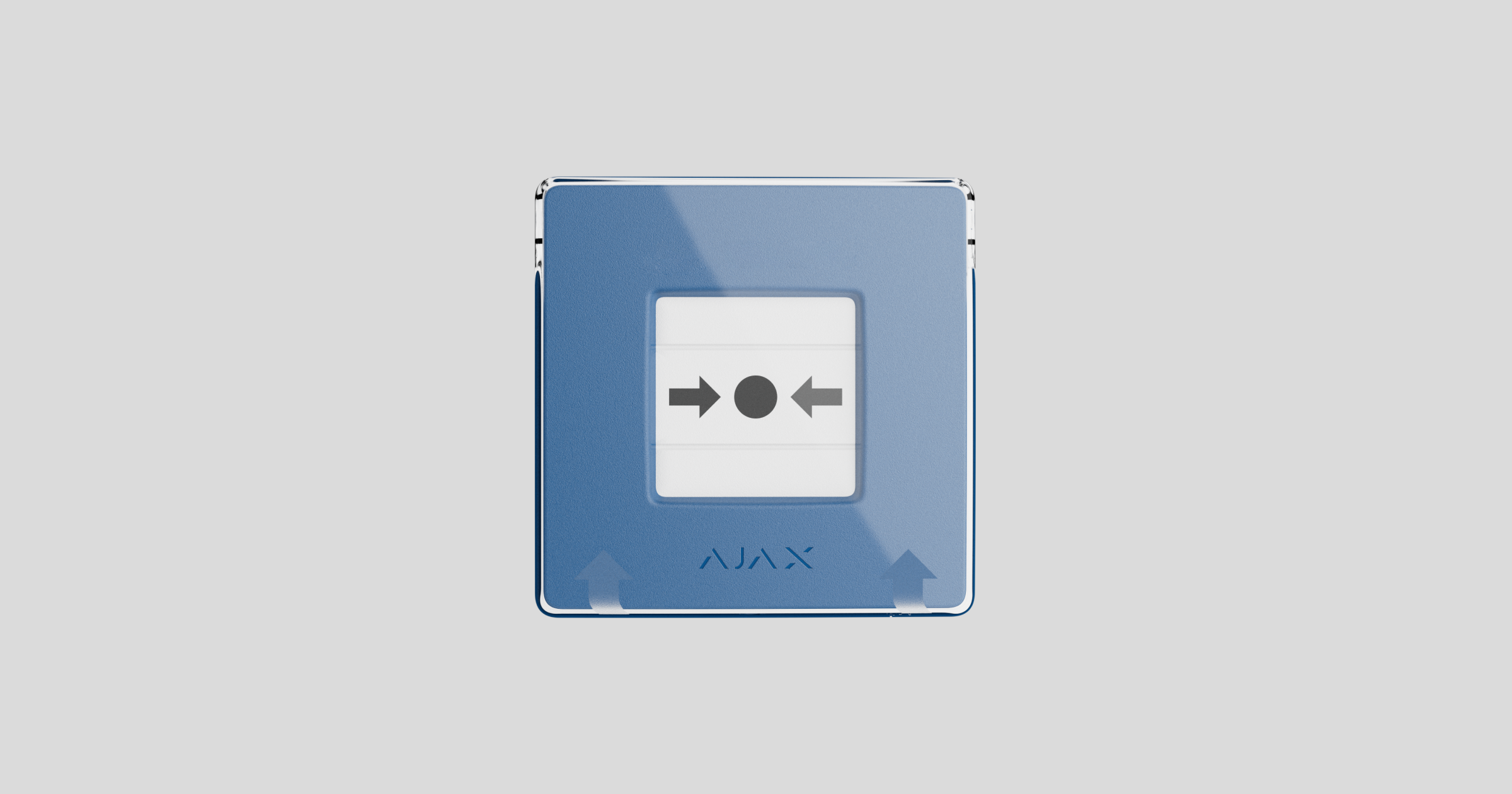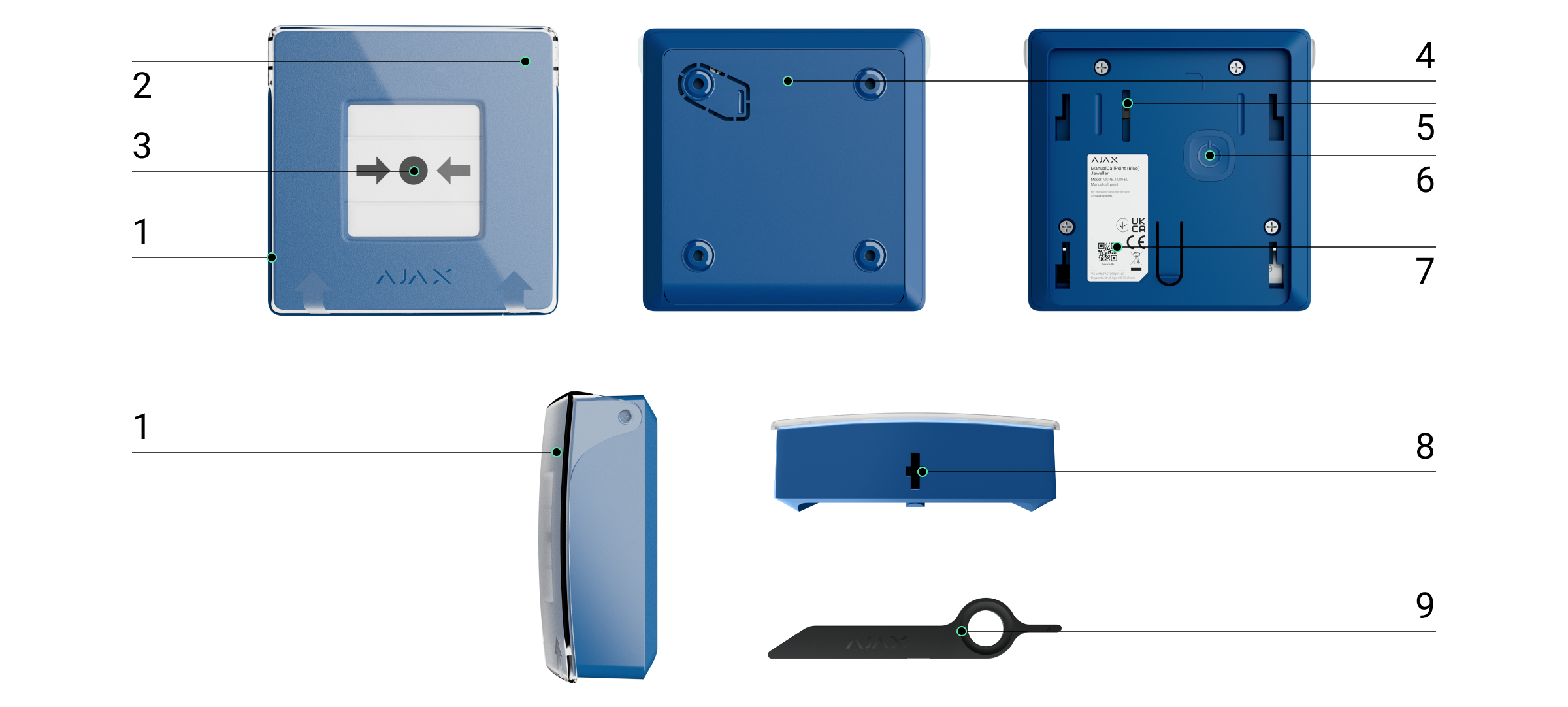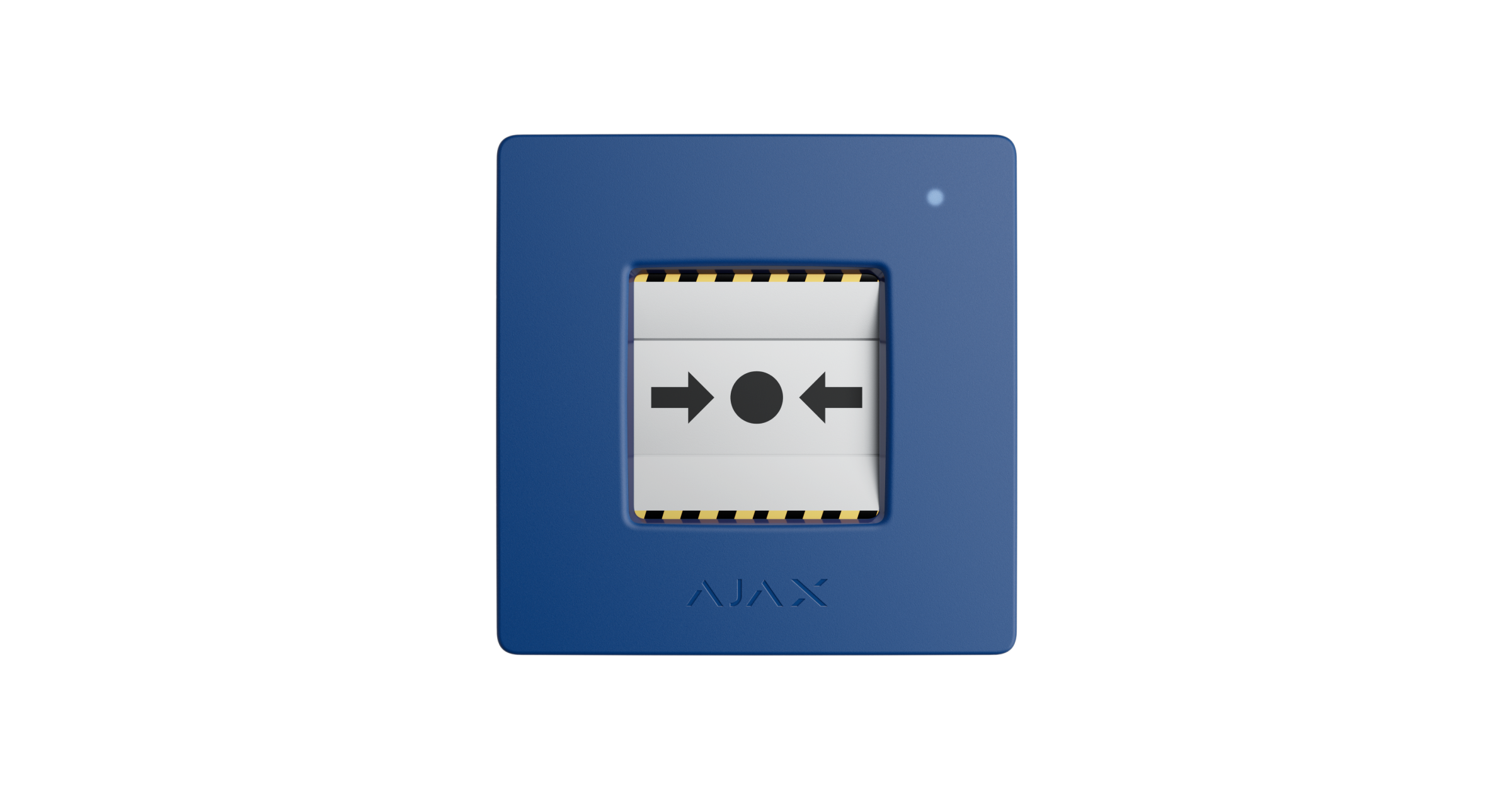ManualCallPoint Jeweller é uma botoneira reiniciável sem fios com cenários programáveis. O dispositivo permite ativar cenários de automatização ou alarmes em caso de emergência. A botoneira pode ser reiniciada utilizando uma ferramenta especial (chave) incluída no kit. O dispositivo foi concebido apenas para instalação no interior.
A botoneira está disponível em várias versões:
- ManualCallPoint (Blue) Jeweller;
- ManualCallPoint (Green) Jeweller;
- ManualCallPoint (Yellow) Jeweller;
- ManualCallPoint (White) Jeweller.
Cada versão tem uma funcionalidade idêntica. No entanto, ao contrário das outras versões, o modo de funcionamento padrão de ManualCallPoint (Red) Jeweller é Alarme de incêndio. Saiba mais
Para transmitir alarmes e eventos, ManualCallPoint Jeweller comunica com o hub ou a central de sinalização e comando (CDI) através do protocolo seguro Jeweller. O alcance de comunicação do hub é de até 1.700 metros sem obstáculos.
Elementos funcionais
- Tampa protetora transparente.
- Indicador LED.
- Elemento frangível rearmável.
- Painel de instalação SmartBracket.
- Botão de tamper anti-sabotagem. É acionado quando alguém tenta separar a carcaça da botoneira da superfície ou retirá-la do painel de instalação.
- Botão de alimentação.
- Código QR com o ID do dispositivo para emparelhar a botoneira com um hub Ajax.
- Furo para a ferramenta especial.
- Ferramenta especial (chave).
Hubs, CDI e repetidores compatíveis
ManualCallPoint Jeweller requer o hub Ajax ou a CDI Ajax com uma versão atualizada de OS Malevich.
Princípio do funcionamento
ManualCallPoint Jeweller ativa o acionamento do cenário ou alarme em caso de emergência. Levante a tampa protetora transparente (se instalada) e pressione a parte central (elemento frangível rearmável) para ativar. Esta ação desloca o elemento frangível para o interior, fazendo disparar o alarme. Duas faixas amarelas aparecerão na parte superior e inferior, indicando o estado do dispositivo.
ManualCallPoint Jeweller pode ser adicionado ao hub Ajax ou à Ajax CDI. O funcionamento do dispositivo no sistema depende disto.
Quando é adicionado ao hub Ajax
Por defeito, o sistema ativa os dispositivos de automatização Ajax através de cenários, como ligar ou desligar a alimentação dos dispositivos e desbloquear a saída. Quando ManualCallPoint Jeweller é acionado, os utilizadores e uma central recetora de alarmes (CRA) ligada recebem uma notificação no separador de eventos Casa inteligente. A reinicialização de ManualCallPoint Jeweller com uma ferramenta especial (chave) também pode ativar um cenário.
Utilize ManualCallPoint Jeweller para alertar sobre incêndios, potenciais fugas de gás ou água, problemas com dispositivos ou outras emergências nas instalações. Dependendo das definições da botoneira, o sistema ativa sirenes Ajax após premir ManualCallPoint Jeweller. Quando o modo de funcionamento de Alarme de incêndio está ativado, o sistema ativa adicionalmente os sinais sonoros integrados dos detetores de incêndio Ajax e o alarme de incêndio interligado , se estiver ativado. As sirenes permanecem ativas até que ManualCallPoint Jeweller seja reposto. Para reiniciar o dispositivo, insira a chave especial incluída no furo correspondente.
Após a reinicialização, a botoneira está pronta a ser reutilizada.
O dispositivo possui uma tampa transparente para evitar pressões acidentais durante a sua instalação e utilização. No entanto, a instalação da tampa é opcional.
ManualCallPoint Jeweller funciona em diferentes modos: Alarme de incêndio, Alarme auxiliar, Botão de pânico, Alarme de fuga de gás, Alerta de avaria, Alarme de fuga de água e Ativação do cenário (por defeito).
Em todos os modos, exceto em Ativação do cenário, a botoneira gera um alarme independentemente do modo de segurança e ativa os cenários de alarme que envolvem este dispositivo. O sistema também transmite um sinal de alarme para a CRA e utilizadores na app. O primeiro é opcional e pode ser configurado nas definições da botoneira.
O sistema pode ser configurado para enviar Alertas críticos que ignoram as definições de «silêncio» ou «não incomodar» do telemóvel.
No modo Ativação do cenário, ManualCallPoint Jeweller permite controlar um ou mais dispositivos de automatização pressionando a botoneira.
Para associar uma ação de dispositivo de automatização à botoneira de ManualCallPoint Jeweller, siga estes passos:
- Abra a app Ajax e aceda ao separador Dispositivos
.
- Selecione ManualCallPoint Jeweller da lista de dispositivos e aceda às Definições clicando no ícone de engrenagem
.
- Selecione o modo Ativação do cenário na secção Modo de funcionamento.
- Aceda ao menu Cenários. Se estiver a criar um cenário pela primeira vez, clique em Criar cenário. Se já criou cenários no sistema, clique Adicionar cenário.
- Selecione um ou mais dispositivos de automatização para executar a ação.
- Introduza o Nome do cenário e especifique a Ação do dispositivo a ser executada, premindo ManualCallPoint Jeweller:
- Liga-se;
- Desliga-se.
- Se tiver selecionado vários dispositivos, especifique qual deles irá ativar o cenário: qualquer um da lista ou todos os dispositivos selecionados durante o tempo definido.
A definição Ação do dispositivo não está disponível ao configurar um cenário para dispositivos de automatização que funcionam no modo de impulso. Quando o cenário é executado, estes dispositivos fecham/abrem os contactos durante um período de tempo definido. É possível ajustar o modo de funcionamento e a duração do impulso nas definições do dispositivo de automatização.
- Clique em Guardar. O novo cenário aparecerá agora na lista de cenários do dispositivo.
Quando é adicionado à Ajax CDI
Os dispositivos Ajax de EN54 Line ligados à CDI são atribuídos a uma das 40 Zonas de incêndio. Quando um incêndio é detetado em qualquer zona ou ManualCallPoint Jeweller é premido, todas as sirenes e VADs de Ajax EN54 em toda a instalação disparam um alarme, e os relés de EN54 I/O Module (2X2) Jeweller são ativados.
ManualCallPoint Jeweller funciona em diferentes modos: Alarme de incêndio, Evacuação, Alarme auxiliar, Alarme de fuga de gás, Alerta de falha, Alarme de fuga de água e Ação personalizada (por defeito).
Em todos os modos, exceto em Ação personalizada, a botoneira gera um alarme independentemente do modo de segurança e ativa os cenários de alarme que envolvem este dispositivo. O sistema também transmite um sinal de alarme para a CRA e utilizadores na app. O primeiro é opcional e pode ser configurado nas definições da botoneira.
Envio de eventos para a central de monitorização
O sistema Ajax pode transmitir alarmes tanto para a app de monitorização PRO Desktop como para a CRA nos formatos SurGard (Contact ID), SIA DC-09 (SIA-DCS), ADEMCO 685 e outros protocolos.
O ManualCallPoint Jeweller pode transmitir os seguintes eventos:
- Alarme de incêndio / recuperação.
- Alarme de botão de pânico / recuperação.
- Alarme auxiliar / recuperação.
- Alarme de fuga de gás / recuperação.
- Alarme de falha ou avaria / recuperação.
- Alarme de fuga de água / recuperação.
- Ativação do cenário / ação personalizada.
- Alarme de tamper / recuperação.
- Perda/restabelecimento da ligação ao hub ou à CDI.
- Desativação/ativação permanente da botoneira.
Quando o alarme é recebido, o operador da central recetora de alarmes da empresa de segurança sabe o que aconteceu e sabe exatamente para onde enviar uma unidade de resposta rápida. A capacidade de endereçamento dos dispositivos Ajax permite enviar eventos para PRO Desktop ou para a CRA, incluindo o tipo de dispositivo, o seu nome, a divisão virtual, o grupo de segurança ou a zona de incêndio e a descrição da localização. Note que a lista dos parâmetros transmitidos pode variar dependendo do tipo da CRA e do protocolo de comunicação selecionado.
O ID e o número do circuito (zona) do dispositivo podem ser encontrados nos seus estados na app Ajax.
Adicionar ao sistema
ManualCallPoint Jeweller é incompatível com Hub (2G) Jeweller, os painéis de controlo de segurança de terceiros ou com os módulos de integração ocBridge Plus e uartBridge.
Para ligar ManualCallPoint Jeweller ao hub ou à CDI, o dispositivo deve estar localizado nas mesmas instalações protegidas que o sistema (dentro do alcance da rede de rádio do hub ou da CDI).
Ao utilizar um repetidor de sinal de rádio, adicione primeiro ManualCallPoint Jeweller ao hub ou à CDI e, em seguida, ligue-o ao repetidor nas suas definições. O repetidor EN54 Fire ReX Jeweller, compatível com a CDI, estará disponível mais tarde.
O hub ou a CDI e o dispositivo que funciona em diferentes radiofrequências são incompatíveis. A gama de radiofrequências do dispositivo pode variar consoante a região. Recomendamos comprar e utilizar dispositivos Ajax na mesma região. Pode verificar a gama de radiofrequências de funcionamento com o serviço de suporte técnico.
Antes de adicionar um dispositivo
- Instale a app Ajax.
- Inicie sessão na sua conta ou crie uma nova conta.
- Selecione um espaço ou crie um novo.
- Adicione pelo menos uma sala virtual.
- Adicione um hub ou uma CDI compatível ao espaço. Certifique-se de que o hub ou a CDI está ligado e tem acesso à Internet através de Ethernet, Wi-Fi e/ou rede móvel.
- Certifique-se de que o espaço está desarmado e de que o hub ou a CDI não estão a iniciar uma atualização, verificando os estados na app Ajax.
Apenas um PRO ou um administrador de espaço com direitos para configurar o sistema pode adicionar um dispositivo ao hub ou à CDI.
Ligação ao hub ou à CDI.
- Abra a app Ajax. Selecione um espaço ao qual pretende adicionar o dispositivo.
- Aceda ao separador Dispositivos
e toque em Adicionar dispositivo.
- Digitalize o código QR ou introduza o ID manualmente. Um código QR com o ID é colocado na carcaça do dispositivo sob o painel de instalação SmartBracket. Também, está duplicado na embalagem do dispositivo.
- Atribua um nome ao dispositivo.
- Selecione uma divisão virtual.
- Se ManualCallPoint Jeweller se ligar ao hub, selecione um grupo de segurança (se Modo de grupo estiver ativado). Se ManualCallPoint Jeweller se ligar à CDI, selecione uma zona de incêndio e especifique a localização do dispositivo no campo Localização.
- Selecione Adicionar dispositivo, e a contagem decrescente começará.
- Ligue o dispositivo mantendo premido o botão de alimentação. Quando o dispositivo é adicionado, o LED pisca uma vez.
Ao ligar ManualCallPoint Jeweller através do repetidor do sinal de rádio, a botoneira não muda automaticamente entre as redes de rádio do repetidor e do hub. No entanto, pode atribuir manualmente ManualCallPoint Jeweller a outro hub ou repetidor na app..
Se atingiu o número máximo de dispositivos que o hub ou a CDI suportam (dependendo do modelo), receberá uma notificação ao tentar adicionar outro dispositivo.
Após ligação ao hub ou à CDI, a botoneira aparecerá na lista dos seus dispositivos na app Ajax.
ManualCallPoint Jeweller funciona com um hub ou uma CDI. Quando ligado a um novo hub ou CDI, o dispositivo deixa de enviar eventos para o antigo. A adição da botoneira a um novo hub ou CDI não a remove automaticamente da lista de dispositivos do antigo. Isto deve ser feito através da app Ajax.
Avarias/Falhas
Quando ManualCallPoint Jeweller é adicionado ao hub, o sistema indica uma avaria. Quando o dispositivo é adicionado à CDI, o sistema indica uma falha. De acordo com a norma EN 54, uma falha é uma condição crítica que afeta o funcionamento do sistema de deteção de incêndios.
Quando uma avaria ou uma falha é detetada, a app Ajax apresenta um contador no ícone do dispositivo. Todas as avarias e falhas são indicadas nos estados do dispositivo. Os campos correspondentes serão destacados a vermelho.
Uma avaria ou uma falha é apresentada quando:
- não há ligação com o hub (ou a CDI) ou repetidor de sinal de rádio (em breve) através de Jeweller;
- as pilhas da botoneira estão fracas.
Ícones
Os ícones na app apresentam alguns estados de ManualCallPoint Jeweller. Para aceder aos mesmos:
| Ícone | Valor |
|
A intensidade de sinal de Jeweller apresenta a intensidade de sinal entre o hub ou a CDI e a botoneira. O valor recomendado é de 2 a 3 barras quando ManualCallPoint Jeweller é adicionado ao hub, e de 3 barras quando o dispositivo é adicionado à CDI. |
|
|
Nível de carga das pilhas da botoneira. |
|
| A botoneira funciona através de um repetidor de sinal de rádio. | |
| O teste da botoneira está em curso. | |
| A botoneira tem uma falha. A lista de falhas está disponível nos estados do dispositivo. | |
| A botoneira é premida. | |
|
A botoneira é permanentemente desativada. O ícone pode ser apresentado se ManualCallPoint Jeweller for adicionado ao hub. |
|
|
A botoneira tem os alarmes de tamper permanentemente desativados. O ícone pode ser apresentado se ManualCallPoint Jeweller for adicionado ao hub. |
|
| A botoneira está desativada. O ícone pode ser apresentado se ManualCallPoint Jeweller for adicionado à CDI. | |
| O dispositivo perdeu a ligação com o hub (a CDI) ou o hub (a CDI) perdeu a ligação com o servidor Ajax Cloud. | |
|
O dispositivo não foi transferido para o novo hub ou a CDI. |
Estados
Os estados incluem informações sobre o dispositivo e os seus parâmetros de funcionamento. Pode encontrar os estados de ManualCallPoint Jeweller em apps Ajax:
- Aceda ao separador Dispositivos
.
- Selecione o ManualCallPoint Jeweller na lista.
| Parâmetro | Valor |
| Alarme |
A botoneira foi premida no modo Alarme de incêndio ou Evacuação. O campo só aparece se for detetado um incêndio. |
| Importação de dados | Apresenta o erro aquando da transferência de dados para o novo hub ou CDI:
|
| Falha |
Clique no botão O campo só aparece se for detetada uma falha. Segundo a norma EN 54, uma falha é uma interferência crítica no funcionamento do sistema de deteção de incêndios. |
| Avaria |
Clique no botão O campo só aparece se for detetada uma avaria. De acordo com a norma EN 54, uma avaria não é uma interferência crítica para o funcionamento do sistema de deteção de incêndios. |
| Desativado |
O dispositivo está desativado. Não responde ao alarme nem notifica os utilizadores e central recetora de alarmes. Ao tocar em O campo só aparece se o dispositivo estiver desativado. |
| Teste |
O teste do dispositivo está em curso. O campo é exibido apenas se ManualCallPoint Jeweller for adicionado à CDI. |
| Temperatura |
Temperatura do dispositivo. É medida pelo processador e muda consoante a temperatura ambiente. É possível configurar um cenário por temperatura para controlar dispositivos de automatização. |
| Intensidade do sinal Jeweller |
Intensidade do sinal entre o hub (a CDI) ou o repetidor e a botoneira no canal Jeweller. O valor recomendado é de 2 a 3 barras quando ManualCallPoint Jeweller é adicionado ao hub e de 3 barras quando é adicionado à CDI. |
| Ligação através de Jeweller | Estado da ligação no canal Jeweller entre o dispositivo e o hub (a CDI) ou o repetidor:
|
| ReX | Estado da ligação entre o dispositivo e o repetidor de sinal de rádio. |
| Carga da bateria | Nível de carga da bateria do dispositivo. Estão disponíveis dois estados:
|
| Tampa | O estado do botão de tamper que responde à separação ou abertura da carcaça do dispositivo:
|
| Estado atual | Se o dispositivo estiver a funcionar nos modos Alarme de incêndio, Evacuação, Alarme auxiliar, Botão de pânico, Alarme de fuga de gás, Alerta de avaria ou Alarme de fuga de água:
Se o dispositivo estiver a funcionar no modo Ativação do cenário ou Ação personalizada:
|
| Modo de funcionamento | Quando ManualCallPoint Jeweller é adicionado ao hub, os modos de funcionamento da botoneira são os seguintes:
Quando ManualCallPoint Jeweller é adicionado à CDI, os modos de funcionamento da botoneira são:
|
| Apenas alarme local | Quando ativado, um alarme deste dispositivo não enviará um sinal para a central recetora de alarmes. No entanto, os alarmes dos detetores de incêndio interligados são ativados independentemente do estado deste interruptor. |
| Desativação permanente | Estado da definição de desativação permanente do dispositivo:
O campo é exibido apenas se ManualCallPoint Jeweller for adicionado ao hub. |
| Zona de incêndio |
O número e o nome da zona de incêndio à qual o dispositivo está atribuído. O campo é exibido apenas se ManualCallPoint Jeweller for adicionado à CDI. |
| Sala | O nome da divisão à qual o dispositivo está atribuído. |
| Localização |
Descrição detalhada da localização do dispositivo. O campo é exibido apenas se ManualCallPoint Jeweller for adicionado à CDI. |
| Firmware | Versão do firmware de ManualCallPoint Jeweller. |
| ID do dispositivo | ID do dispositivo. Também disponível no código QR na carcaça da botoneira e na sua embalagem. |
| Número do Dispositivo. | Número do circuito (zona) do dispositivo. |
Definições
Para alterar as definições de ManualCallPoint Jeweller, na app Ajax:
- Aceda ao separador Dispositivos
.
- Selecione o ManualCallPoint Jeweller na lista.
- Aceda a Definições
.
- Defina os parâmetros necessários.
- Clique em Voltar para guardar as novas definições.
| Parâmetro | Valor |
| Nome | Nome do dispositivo. Pode ser alterado. |
| Zona de incêndio |
Seleção da zona de incêndio à qual ManualCallPoint Jeweller está atribuído. A zona de incêndio aparece no texto de SMS e notificações no historial de eventos. A definição só está disponível se ManualCallPoint Jeweller for adicionado à CDI. |
| Sala | Seleção da divisão virtual à qual ManualCallPoint Jeweller está atribuído. |
| Localização |
Descrição detalhada da localização do dispositivo. Aparece ao lado do nome da divisão nas notificações do historial de eventos. O campo de localização pode conter até 24 caracteres latinos ou cirílicos. A definição só está disponível se ManualCallPoint Jeweller for adicionado à CDI. |
| Modo de funcionamento | Seleção do modo de funcionamento da botoneira:
Depois de premir a botoneira em todos os modos, exceto em Ativação do cenário ou Ação personalizada, é enviado um alarme para a app Ajax e para a CRA, e os cenários em que a botoneira está envolvida são ativados. |
| Apenas alarme local | Quando ativado, um alarme deste dispositivo não enviará um sinal para a central recetora de alarmes. No entanto, os alarmes dos detetores de incêndio interligados são ativados independentemente do estado deste interruptor. |
|
Alertar com sirene |
|
| Se a botoneira do MCP for premida |
Quando ativado, premir a botoneira ativará quaisquer sirenes que tenham sido adicionadas ao sistema. A definição só está disponível se ManualCallPoint Jeweller for adicionado ao hub. |
| Cenários |
Abre o menu para criar e configurar os cenários de automatização. A definição só está disponível se ManualCallPoint Jeweller for adicionado ao hub. |
| Teste de intensidade de sinal do Jeweller |
Permite ao utilizador determinar a intensidade e a estabilidade do sinal no local de instalação previsto. |
| Guia do utilizador | Abre o manual do utilizador de ManualCallPoint Jeweller. |
| Desativação permanente |
Permite ao utilizador desativar o dispositivo sem o retirar do sistema. Estão disponíveis três opções:
A definição só está disponível se ManualCallPoint Jeweller for adicionado ao hub. |
| Desativação do dispositivo |
A opção permite desativar o dispositivo ou as suas funções específicas. O dispositivo permanece no sistema, mas deixa de emitir um alarme. A definição só está disponível se ManualCallPoint Jeweller for adicionado à CDI. |
| Eliminar dispositivo | Desliga ManualCallPoint Jeweller do hub ou da CDI e elimina as suas definições. |
Indicação
O ManualCallPoint Jeweller informa sobre o seu estado através de uma indicação LED no canto superior direito do dispositivo.
| Categoria | Indicação | Evento |
| Alarme. | O LED pisca continuamente. | O LED pisca enquanto o elemento frangível for premido. |
| Alarme de tamper. | O LED pisca uma vez. | A botoneira é retirada do painel SmartBracket. |
| Ligação da botoneira. | O LED pisca uma vez. | Para ligar a botoneira, mantenha premido o botão de alimentação durante 1 segundo. |
| Desligação da botoneira. | O LED pisca três vezes. | Para desligar a botoneira, mantenha premido o botão de alimentação durante 2 segundos. |
| Avaria detetada. | O LED pisca continuamente. | |
| Nível de pilhas baixo. | O LED pisca uma vez por minuto. | |
| Pilhas completamente descarregadas. | O LED pisca rapidamente durante um curto período de tempo. |
Teste de funcionalidade
O sistema Ajax oferece vários tipos de testes para ajudar a selecionar o local de instalação correto para os dispositivos. Esses testes não começam imediatamente. No entanto, o tempo de espera não excede a duração de um intervalo de consulta entre o hub e dispositivo. Pode verificar e configurar o intervalo de consulta nas definições do hub ou CDI (Hub (CDI) → Definições → Jeweller ou Jeweller/Fibra).
Para executar um teste, na app Ajax:
- Selecione o espaço pretendido.
- Aceda o separador Dispositivos
.
- Selecione o ManualCallPoint Jeweller na lista.
- Aceda às Definições
.
- Selecione Teste de intensidade do sinal de Jeweller.
- Execute o teste.
Colocação do dispositivo
O dispositivo foi concebido apenas para utilização no interior.
Ao escolher um local para ManualCallPoint Jeweller, considere os parâmetros que afetam o seu funcionamento:
- intensidade do sinal Jeweller;
- a distância entre o dispositivo e o hub (a CDI) ou repetidor de sinal de rádio;
- a presença de barreiras que possam impedir a transmissão de sinais de rádio entre dispositivos, tais como paredes, tetos entre pisos ou objetos de grandes dimensões localizados nas instalações
ManualCallPoint Jeweller deve estar localizado nos caminhos de evacuação, em especial nas saídas de todos os andares e em todas as saídas para o ar livre que conduzam a um local seguro (mesmo que estas saídas não estejam identificadas como saídas de incêndio).
ManualCallPoint Jeweller deve ser fixado a uma altura de 1,4 m acima do nível do piso acabado, em posições de fácil acesso, bem iluminadas e visíveis, livres de possíveis obstruções. Devem ser colocados sobre um fundo contrastante para facilitar o reconhecimento. É aceitável uma altura de montagem inferior se houver uma grande probabilidade de a primeira pessoa a acionar o alarme de incêndio ser um utilizador de cadeira de rodas.
Tenha em conta as recomendações de posicionamento ao planear o sistema de segurança para a instalação. O sistema de segurança deve ser concebido e instalado por profissionais. Uma lista de parceiros recomendados está disponível aqui.
Intensidade do sinal
A intensidade do sinal Jeweller é determinada pelo número de pacotes de dados não entregues ou corrompidos durante um determinado período de tempo. O ícone no separador Dispositivos
indica a intensidade do sinal:
- três barras— excelente intensidade de sinal;
- duas barras— boa intensidade do sinal;
- uma barra— fraca intensidade de sinal, não é garantido um funcionamento estável;
- ícone riscado — sem sinal.
Execute o teste de intensidade do sinal Jeweller antes da instalação final. O teste verifica a intensidade do sinal na potência máxima de transmissão do dispositivo. Para cumprir os requisitos da norma EN 54, a intensidade do sinal entre o dispositivo e a CDI deve ser de três barras.
Se o teste indicar uma intensidade de sinal de uma ou zero barras, não podemos garantir o funcionamento estável do dispositivo. Considere a possibilidade de mudar o dispositivo de lugar, uma vez que o ajuste da sua posição, mesmo que seja de 20 cm, pode melhorar significativamente a intensidade do sinal. Se o sinal continuar a ser fraco ou instável após a relocalização, considere a utilização de um repetidor de sinal de rádio.
Como não instalar a botoneira
- No exterior, pois pode dar origem a falsos alarmes e à falha do dispositivo.
- Em locais onde os níveis de temperatura e humidade estão fora dos limites permitidos, pois isso pode danificar o dispositivo.
- Mais perto do que 1 metro do hub (a CDI) ou do repetidor de sinal de rádio para evitar a perda de ligação com o hub.
- Em áreas com níveis de intensidade de sinal baixos ou instáveis, uma vez que tal pode resultar na perda de ligação com o hub ou a CDI.
- Em locais de difícil acesso ou com pouca iluminação.
Instalação
Antes de instalar ManualCallPoint Jeweller, certifique-se de que selecionou o local ideal, em conformidade com os requisitos deste manual.
Para montar a botoneira:
- Retire o painel de instalação SmartBracket da botoneira. Para fazer isso, insira a ferramenta especial no orifício e deslize a placa de montagem para baixo.
- Fixe o painel de instalação SmartBracket utilizando fita adesiva de dupla face ou outros fixadores temporários. Coloque o painel de instalação numa superfície vertical a uma altura de 1,4 metros.
Utilize fita adesiva de dupla face apenas para a fixação temporária. Se o dispositivo estiver fixado apenas com fita adesiva, poderá soltar-se da superfície a qualquer momento e o tamper não será acionado se o dispositivo for removido.
- Coloque a botoneira, com a tampa transparente fechada, no painel SmartBracket. O indicador LED do dispositivo pisca, sinalizando que o tamper na botoneira está fechado.
- Efetue o teste de intensidade do sinal Jeweller. O objetivo é obter uma intensidade de sinal de duas ou três barras.
- Retire a botoneira de SmartBracket.
- Fixe firmemente o painel SmartBracket utilizando os parafusos incluídos em todos os pontos. Um ponto de fixação está na parte perfurada do painel de instalação acima do tamper. Se utilizar outros elementos de fixação, certifique-se de que não danificam ou deformam o painel de instalação.
- Volte a colocar a botoneira no painel SmartBracket.
A ferramenta especial tem um orifício na sua carcaça, o que a torna fácil de transportar. Os responsáveis pela segurança contra incêndios poderão achar conveniente prender a ferramenta especial ao seu porta-chaves.
Ações a tomar em caso de alarme de incêndio
NUNCA IGNORE O ALARME! Assuma sempre que o alarme é real e evacue o local de imediato, mesmo que tenha dúvidas sobre a causa do sinal de alarme.
- Não abra as portas se sentir calor ou fumo atrás delas. Verifique outras saídas e utilize uma forma alternativa de escapar. Feche sempre as portas atrás de si quando sair.
Se entrar fumo intenso numa divisão, mantenha-se perto do chão e saia a rastejar. Se possível, respire através de um pano molhado ou tente suster a respiração. A inalação de fumo causa mais mortes do que o fogo.
- Evacue o mais rapidamente possível, não entre em pânico. Poupe tempo, não faça as malas. Organize um ponto de encontro no exterior para todas as pessoas do edifício. Certifique-se de que todas as pessoas foram evacuadas em segurança.
- Chame imediatamente os bombeiros, ou peça a alguém que esteja por perto. Lembre-se, mesmo pequenos incêndios podem se espalhar rapidamente; chame os bombeiros mesmo que o alarme seja transmitido automaticamente para uma central recetora de alarmes.
NUNCA volte para a casa em incêndio.
Manutenção
Limpe a carcaça do dispositivo do pó, teias de aranha e outros contaminantes à medida que vão surgindo. Utilize panos macios e secos adequados para limpar equipamentos eletrónicos. Ao limpar o dispositivo, evite o uso de substâncias que contenham álcool, acetona, gasolina e outros solventes ativos.
As pilhas pré-instaladas duram até 7 anos com uma utilização normal (uma pressão de um minuto por semana). A utilização mais frequente pode reduzir a sua vida útil. Pode verificar o nível das pilhas em qualquer altura na app Ajax.
Características técnicas
Garantia
A garantia dos produtos da «Ajax Systems Manufacturing» Limited Liability Company é válida durante 2 anos a partir da data de compra.
Se tiver algum problema com a funcionalidade do dispositivo, recomendamos que contacte primeiro o Suporte Técnico Ajax. Na maioria dos casos, os problemas técnicos podem ser resolvidos remotamente.
Contactar o Suporte Técnico:
Fabricado por «AS Manufacturing» LLC





